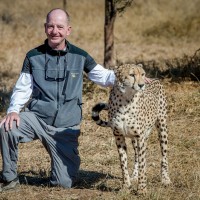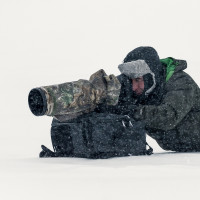SEARCH






|
|
|
|


by Editor Lourens Durand
Colours and patterns, besides offering interesting material for photographers, are crucial to the survival of wildlife, birds and plant species in the natural world.
Camouflage immediately comes to mind; a natural colouring or form allowing an animal to blend in with its surroundings. The simplest form of camouflage is countershading. Frogs make use of countershading as a protection against predators by being lighter on the bottom (to appear to blend with the sky to predators from below in ponds) and darker above (to bend with the muddy bottom of ponds to predators from above).
South Africa’s Impala and Springbok also exhibit countershading: their backs are darker than their flanks, which are darker than their bellies, helping to break up their shapes when standing absolutely still.
The Kudu, on the other hand, has stripes across its back as disruptive marking rendering it almost impossible to distinguish when it stands motionless amongst trees.
Other disruptive markings that break up the outline of the body are the spots of leopards and young lions, allowing them to blend in with dappled light and almost invisible against foliage. Older lions have a sandy colour mingling in with grassland and sandy patches.
Cheetah also have spots, but their cubs have mantles of hair down their backs so that they resemble ferocious honey badgers and, at the same time, camouflaging them in grasslands, thus offering them some protection whilst still vulnerable.
Another marking type that is prevalent is “follow me” marking:
*The black tip of a lion’s raised tail, as well as the black patches behind the ears are easy for their cubs to follow in long grass.
*Leopards have white-tipped tails.
*Impala have white tails that they raise and flare out as signals to the herd when fleeing from prey.
*Giraffe have white marks behind their ears for the same reason.
Coming back to camouflage, some birds (grouse, for example) have stripes, spots or patterns as disruptive markings allowing them to blend with the background.
Others exhibit cryptic camouflage in the form of mottled colours reflecting their environment as, for example, the Scops Owl that is almost invisible against the bark of a tree or, when perched on an open branch, may be disguised as a loose piece of bark.
Male birds, of course, make use of brightly coloured feathers during courtship to attract potential mates. This is often accompanied by a physical change, such as long flight feathers and a decorative tail.
Once the courtship has been concluded the males moult back to a nondescript plumage, but the eggs that result from the mating are often camouflaged to foil potential predators. When nests are on the ground, the eggs resemble the ground and surrounding areas and are mostly speckled. Those in trees are also appropriately disguised when necessary or, if out of reach of terrestrial predators, they may be white, as are the eggs that are laid in tree cavities.
Another form of disguise, often seen in the insect world, is mimicry. Here, a non-dangerous species is transformed into a tough customer as, for example, with the eye-spots on the wings of butterflies and moths, appearing to become much bigger and so scaring off potential predators.
Some butterflies have, in addition, long tails that, combined with wing patterns resemble a large head, warding off unwanted attention.
Another trick used by insects and other animals is aposematic colouring – bright red and yellow or harsh black and white colours that stand out against the background – the opposite of camouflage.
This warns potential predators that the animal or insect is poisonous (some caterpillars, for example) or unpalatable (ladybirds are bitter).
The chameleon, of course, is the master of camouflage, changing colour at will either to attract a mate or discourage a rival, or to thermoregulate.
It is not only the animal kingdom that makes use of colour and patterns: seeds embedded in fruits that have bright colours and nutritious flesh attract birds and animals to eat and disperse them when defecating or spitting them out, with a greater chance of distribution and survival.
To cap it all, nature simply provides us humans with a spectacular canvas of ever-changing colours and patterns for our own delight and an endless supply of subject matter for photographers.
Published by Yvette Depaepe
Head of the Editorial Team
 | Write |
 | Jeffrey C. Sink PRO thank you sincerely for including my image - huge honor |
 | Vladimir Asriyan A wonderful selection of amazing, fantastic photos.
Thank you Lourens. Thank you Ivette. |
 | Mohammad Soheilinia The registration of the wildlife world and the unique examples of animals and insects is a valuable and indispensable element, apart from being extremely dangerous and dangerous,All the images are amazing and beautiful, and they showcase the bestiality of these creatures in the best,I appreciate all the respectable photographers, and I also thanked yvette, who has always been my photographer's lamp, and taught me this in the least,In the end I have to say that the images I see on this site are very professional and even looking at them makes me eccentric,thanks to ALL and GOOD BYE. |
 | Yvette Depaepe CREW Thanks for your appreciation and huge compliment, Mohammad! |
 | Marco Pozzi PRO Thank you so much! Glad and proud to have been considered for this article
best
marco |
 | Yvette Depaepe CREW Our natural world is full of colourful patterns, indeed! Fine article and great choice of images, Lourens! Congratulations to all the authors... Cheers, Yvette |